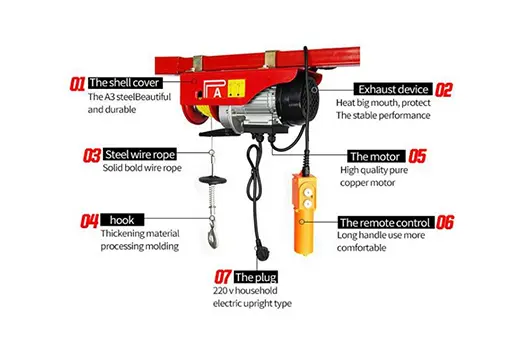


The Mini Hoist Compact Power for Lifting 100kg
In the realm of lifting equipment, the mini hoist has emerged as a practical solution for both industrial and domestic applications. Specifically designed to lift loads up to 100kg, these compact machines offer a remarkable blend of convenience, efficiency, and safety, making them indispensable tools for various tasks.
Understanding Mini Hoists
A mini hoist is a lightweight, portable lifting device that typically comprises an electric motor, a pulley system, and a suspension hook. Despite its small size, a mini hoist is engineered to provide powerful lifting capabilities, often exceeding traditional manual lifting methods. The ability to lift 100kg places mini hoists in a category that accommodates a wide range of applications—from home improvement projects and construction sites to warehouse operations and automotive repairs.
Applications of Mini Hoists
The versatility of mini hoists allows them to be used in numerous scenarios. In the construction industry, for instance, workers can use a mini hoist to move heavy materials such as bricks, tiles, and tools efficiently, reducing the risk of injury associated with manual lifting. Moreover, in automotive settings, a mini hoist can facilitate the lifting of engines or parts, making repairs and replacements quicker and less labor-intensive.
For DIY enthusiasts and homeowners, mini hoists provide an easy solution for tasks such as lifting heavy furniture, appliances, or even outdoor gear. Whether it’s hoisting a washing machine into position or installing a ceiling fan, a mini hoist can make previously laborious tasks simpler and safer.
Key Features to Consider

When considering the purchase of a mini hoist, several key features should be taken into account. Firstly, the lifting capacity should align with the maximum weight of items you intend to move. A mini hoist with a capacity of 100kg is ideal for many applications, but it's essential to ensure that this capacity fits the specific needs of your tasks.
Another important feature is the hoist’s lifting height. Depending on the intended use, you may require a mini hoist that can lift items to a significant height. Therefore, it's crucial to check the specifications to ensure it meets your requirements.
Additionally, the power source of the mini hoist is paramount. While many mini hoists are electrically powered, there are also battery-operated options available. Electric hoists offer continuous power, making them suitable for prolonged tasks, while battery-operated models provide the advantage of portability without the need for a power outlet.
Safety features are also essential when selecting a mini hoist. Look for models that include protective mechanisms such as overload protection, emergency stop buttons, and secure hooks to ensure safe operation at all times.
The Future of Mini Hoists
As technology advances, the design and functionality of mini hoists continue to evolve. Innovations in weight sensors, remote controls, and automated systems are being integrated into new models, enhancing usability and safety. The rise of smart technology is likely to lead to the development of app-controlled mini hoists that allow users to manage lifting operations remotely, further streamlining processes.
Conclusion
The mini hoist's capacity to lift 100kg makes it a versatile tool across various sectors. Its portability and ease of use enable safer, more efficient lifting solutions for both professionals and casual users alike. Whether you’re engaging in construction, automotive repairs, or DIY projects, investing in a mini hoist can significantly enhance your productivity and safety. As we look to the future, ongoing advancements in technology promise even greater efficiency and functionality, solidifying the mini hoist's role as a vital lifting solution in our everyday lives.



